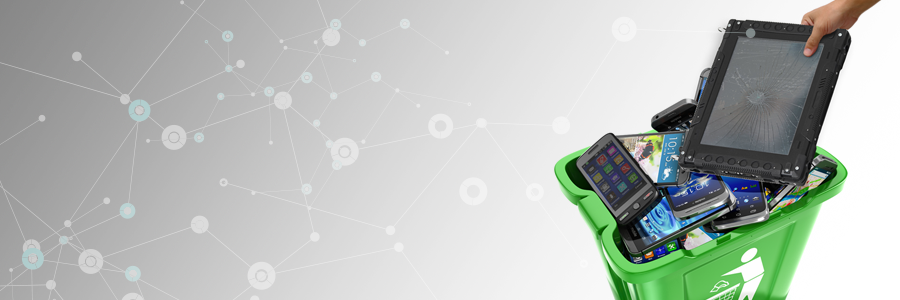
Recycling is not relatively new:
- 1031: The first recorded use of recycled paper in Japan when old documents were shredded and remade into new sheets of paper
- 1776: Metal recycling made its way to the U.S. when a statue of King George III was torn down, melted and converted into bullets
- 1939-1945: During World War II, over 400,000 people volunteered to collect and sort tin, rubber and steel to help with the war effort
- 1970: The ubiquitous “chasing arrows” recycling symbol was introduced and really brought recycling into public awareness
- 1983: Blue box recycling first appeared in Canada
Paper. Metal. Glass. Tin. Rubber. Steel. Some of these traditional materials have been recycled at home and for almost 1,000 years – literally.
However, the latest SOTI report, Reduce, Reuse, Rethink: From Discard Mentality to Tech Sustainability, looks at recycling more modern items such as mobile devices and e-waste in the enterprise. Are businesses in all industries reducing, reusing and recycling smartphones, tablets and printers? Or are they simply discarding them unnecessarily for the latest and greatest available device?
have ENTERPRISES DISCARDED THE DISCARD MENTALITY?
Download SOTI's Sustainability Report to Find OutToo Much E-Waste. Not Enough Mobile Device Recycling
In the enterprise, perhaps no items are so easily discarded and replaced – even if they are still in safe, secure operating condition – than mobile devices.
The numbers from Reduce, Reuse, Rethink: From Discard Mentality to Tech Sustainability confirm that IT decision-makers default to disposing devices needlessly:
- 55% say that all enterprise devices are disposed of unnecessarily
- 69% agree that mobile phones are the most common unnecessarily discarded device, followed by wearables (68%), tablets (65%), rugged handhelds (60%) and printers (55%)
- 52% of respondents admitted to replacing laptop computers and tablets at the end of their expected lifespans rather than when they stop working
Does this mean that businesses or IT simply do not care about the environment or sustainability?
Nope. Not at all.
What it does signify, rather, is that it’s easier to assume devices will stop working or become obsolete earlier than expected. Therefore, it’s faster (and more convenient) to replace them outright versus extending their lifespan or recycling or repurposing them.
This is where the concept of “think globally, act locally” comes into play. Needlessly discarding a few smartphones or printers doesn’t seem like much. But globally in 2019, 54 million metric tons of e-waste was generated.
What’s Next Isn’t Always What’s Best (For the Environment)
As referenced in the report, 45% of IT decision-makers dispose of older, perfectly capable and still in good working condition devices simply because an updated model is available.
The term “older” is a bit of a misnomer because, on average, the smartphones in the enterprise are replaced every 2.42 years. By 2025, that number is expected to shrink to 2.28 years.
Math time: If an organization issues smartphones to 1,000 employees, and if the average smartphone is replaced every 2+ years, that means the business will purchase approximately 5,000 devices over a 10 year span, 4,000 of which will end up being disposed of.
More math: The average smartphone is 0.35” (8.9 mm) thick. Stacked 4,000 high, that’s a tower of perfectly good smartphones over 116 feet in height needlessly taken out of circulation. For reference, the average telephone pole is only 36 feet tall.
It’s far too easy – and it happens far too often – for mobile devices to be discarded as a preventative, precautionary measure or because the latest and greatest version is now available. Somewhere along the line, a mindset shift took place: before, the focus was on having smartphones, tablets and other mobile devices last longer; now, the idea is how to get the newest device as quickly as possible.
All of this raises a few questions:
- Does having the latest device, at the expense of older devices which still perform as expected, help with end user productivity and bottom line performance? Maybe.
- Does having the latest hardware devices help with organizational prestige and perception? According to the report, 62% of respondents say it does make their company more attractive to workers.
- Is constantly replacing and discarding mobile devices good for the environment and help with Green IT initiatives? Absolutely not.
The challenge is how to balance productivity with sustainability without defaulting to a discard mentality.
FOR FURTHER READING
What is Green IT & Why Should You Care?It’s Simple to Be Sustainable
To reduce e-waste and improve mobile device recycling habits in the enterprise, it’s critical to first move away from preconceived notions regarding device deployments.
Here’s one: device battery failure automatically means that the device itself needs to be replaced or that all batteries in all devices are on the verge of failure and, as such, should be discarded.
That’s the easy road to take, but it’s not the sustainable one.
Battery failure is a common issue among enterprise IT and mobile device users. Nearly 80% of businesses experience mid-shift battery failure and when it does happen, workers lose an average of 50 minutes of productivity. Keeping batteries healthy and devices online is a top priority, but it shouldn’t be done at the expense of the environment.
A more eco-friendly mindset is to look into all deployed and in-use batteries and replace and discard only those which need to be. Shifting from blanket generalizations to accessing specific, pinpoint data can help organizations reduce, reuse and rethink how they manage e-waste and mobile device recycling.
But that’s just the beginning. There are other solutions or steps businesses can take.



